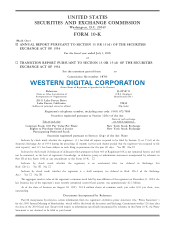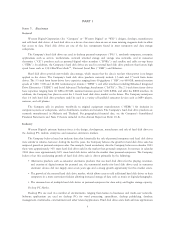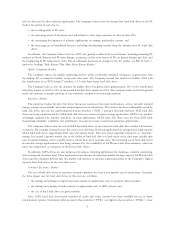Western Digital 2005 Annual Report Download - page 17
Download and view the complete annual report
Please find page 17 of the 2005 Western Digital annual report below. You can navigate through the pages in the report by either clicking on the pages listed below, or by using the keyword search tool below to find specific information within the annual report.design and manufacture a substantial portion of the heads, head gimbal assemblies (""HGAs'') and head stack
assemblies (""HSAs'') for use in hard disk drives it manufactures.
For an additional discussion of manufacturing, see Part II, Item 7, under the heading ""Risk Factors That May
Affect Future Results.''
Research and Development
The Company devotes substantial resources to development of new products and improvement of existing products.
The Company focuses its engineering efforts on coordinating its product design and manufacturing processes in order to
bring its products to market in a cost-effective and timely manner. Research and development expenses totaled
$239 million, $201 million and $135 million in 2005, 2004 and 2003, respectively.
For further discussion of product development, see Part II, Item 7, under the heading ""Risk Factors That May
Affect Future Results.''
Materials and Supplies
The principal components currently used in the manufacture of the Company's hard disk drives are magnetic heads
and related HSAs, media, controllers, spindle motors and mechanical parts used in the head disk assembly. In addition to
custom semiconductor devices, the Company also uses standard semiconductor components such as logic, memory and
microprocessor devices obtained from other manufacturers and a wide variety of other parts, including printed circuit
boards, connectors, cables, and other interconnect technology.
The Company designs and manufactures a substantial portion of the heads required for the hard disk drives it
manufactures. The Company also purchases a portion of these components from third party suppliers. During 2005, the
Company bought giant magnetoresistive heads from ALPS Electric Co., Ltd. and TDK Corporation's subsidiary, SAE
Magnetics Ltd.
The Company acquires all of the remaining components for its products from third party suppliers. The Company
generally obtains multiple suppliers for each of its component requirements, however, in some instances for business
reasons the Company is sole sourced. For example, during 2005, the Company's media requirements were purchased
from several outside vendors including Fuji Electric, Hoya Corp., Komag Inc. and Showa Denko KK. The Company has
volume purchase agreements with Komag Inc. and Showa Denko KK under which the Company is obligated to purchase
from each supplier, and each supplier is obligated to sell to the Company, certain specified media volumes in accordance
with the terms in the agreements.
Some components are currently sole-sourced. For example, some custom integrated circuit devices for certain
products are currently sole-sourced from STMicroelectronics and Marvell Semiconductor, Inc. Because of their custom
nature, these products require significant design-in periods and long lead times. There has been a trend in integrated
circuit design toward increased integration of various separate circuits. The Company expects this trend to continue in the
area of custom integrated circuits for hard disk drives.
For an additional discussion of component supplies, see Part II, Item 7, under the heading ""Risk Factors That May
Affect Future Results.''
Backlog
Historically, a substantial portion of the Company's orders has been for shipments of hard disk drives within 30 to
60 days of the placement of the order. The Company generally negotiates pricing, order lead times, product support
requirements and other terms and conditions prior to receiving a computer manufacturer's first purchase order for a
product. Customers' purchase orders typically may be canceled with relatively short notice to the Company, with little or
no cost to the customer, or modified by customers to provide for delivery at a later date. In addition, many of the
Company's sales to OEMs are made under just-in-time delivery contracts that do not generally require firm order
commitments by the customer until the time of sale. Instead, the Company receives a periodic forecast of requirements
from the customer, and the customer is invoiced upon shipment of the product from the just-in-time warehouse.
11
























